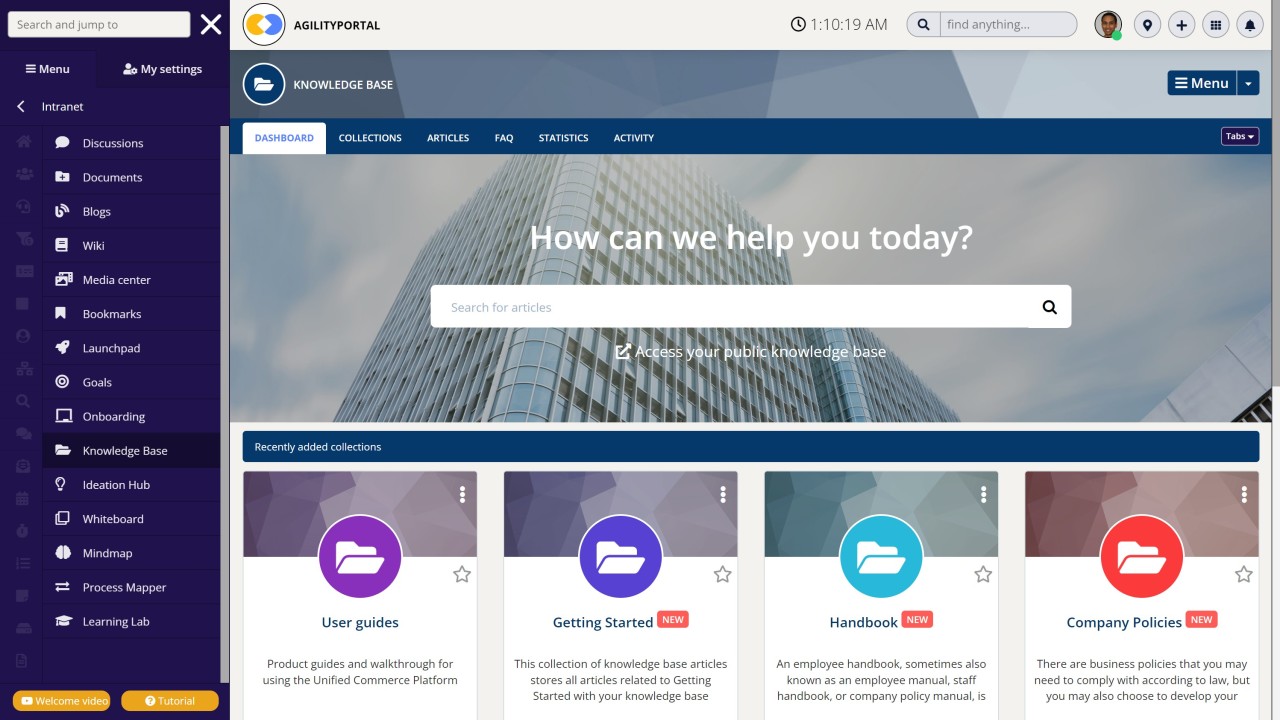Insight Blog
Agility’s perspectives on transforming the employee's experience throughout remote transformation using connected enterprise tools.
7 minutes reading time
(1396 words)
Tips to transfer knowledge when an employee leaves unexpectedly
Handling transfer of knowledge, and determine which tasks need to be reassigned and what knowledge needs to be transferred.
Regardless of how big or small your business is, losing an employee unexpectedly can be difficult. Even if the employee gives two weeks' notice, it may take much longer to find and train a replacement.
You must first gather the crucial knowledge that can be intellectual gold for your company. Its retention in a company is a mission with many intricate aspects to handle. Therefore, instead of waiting to see where the tide takes you, confront it and begin deliberately mending it.
Start making a plan
It takes time to develop a culture that firmly encourages sharing. It takes the longest to develop of the three fronts and cannot be compelled to happen. To thrive here, you must always have tenacity and tenacity.
It takes several iterations for the integration of working methods that itself encourage sharing to attain its full potential. Be patient while you experiment with various models because there is no ideal way to achieve this.
You can discover the working methods that best meet the requirements of your team through iteration. Additionally, keep in mind that you frequently need to adjust as the business and its environment evolve.
- Decide what information you need to keep
- Put together a list of processes for transferring knowledge
- make a list of platform to facilitate knowledge transfer
- Prepare for ongoing knowledge transfer efforts
Utilize tools to transfer knowledge
Utilizing share promotion methods, mostly intranet software, ensures that a positive culture and effective systems are fully utilized. At least two significant characteristics should be present in these tools.
First and foremost, they must be simple to use, always available, and as automated in their operation as possible. Second, they must make it easy and efficient for the task at hand to access and use the data that has been saved.
Without these characteristics, it's highly likely that the tools won't be actively used enough to be helpful in practice.
- AgilityPortal - AgilityPortal is a employee intranet app sharing platform that enables employees to quickly find the information they need to do their jobs. AgilityPortal's software applications aim to increase virtual knowledge and information sharing in the workplace.
- Zendesk Guide - Zendesk Guide is a smart knowledge base that helps tap into that institutional knowledge and puts it to work. With Guide, you can build a customizable help center, online community, and customer portal so customers get better self-service and agents see improved efficiency and faster resolution.
- Tettra - Tettra is a cloud-based knowledge sharing and wiki software for Slack users. It is formatted so anyone can edit the sites created.
- Confluence - Confluence is a collaboration and content sharing platform used primarily by customers who are already using Atlassian's Jira project tracking product. The product appeals particularly to IT users.
- Guru - Guru is a knowledge management platform that integrates with Slack, as well as feeds product information into a company's sales enablement, customer support, and content marketing channels.
- SharePoint - SharePoint is a web-based, collaborative platform that integrates with Microsoft Office. SharePoint usage varies from organization to organization. The product encompasses a wide variety of capabilities, most of which require configuration and governance. The most common uses of the SharePoint include: enterprise content and document management, intranet and social network, file hosting service (personal cloud) and…
- Simpplr - Simpplr is a modern employee intranet that helps companies connect, align, and engage their entire workforce across the enterprise.
Utilize systems that encourage sharing
The system or processes to support this culture can include "checkups" to keep up a weekly or monthly sharing schedule. These gatherings are a wonderful location to impart information that may not normally come up in conversation but is nonetheless crucial.
As the manager of the call center, you might plan weekly end-of-shift gatherings to discuss the greatest difficulties and achievements of the previous week. To make the practice practicable, these meetings should be brief and to the point.
Concentrate on enhancing culture
The atmosphere should encourage openness and cooperation. The process of getting there is, in theory, pretty simple: all that is required is to encourage sharing on all levels, including pointing up errors or voicing grievances. In actuality, that will undoubtedly be a lot more difficult and drawn-out process of gradual development.
- Ensure you have a lot of transparency
- Reward in Public, Coach in Private.
- Make Collaboration the Work Standard
- Establish Channels for Employee Feedback
- Stick to Your Core Values
Identify pressure points and employ the three-front approach
You need to start by mapping the parts of your company that deal with important, secret information that could be lost as employees retire. These sectors could include things like product development or client relations.
It's time to create a quick-acting plan to bring about change on all three fronts of strategic information retention—culture, systems, and tools—after you've identified the key pressure points.
Since the longer you wait, the more vital knowledge you will have already lost, the plan should be simple and quick to implement. Furthermore, if you have some real-world knowledge of what works and what doesn't, making changes to the strategy will be simpler.
Use reflection strategy to share information
It's crucial for employees to routinely share their learning with the team since it establishes a habit for sharing information that might not always get passed along naturally.
Weekly check-ins, for instance, might address both failures and triumphs, helping to acquire tacit knowledge of both the best practices that have been shown to work and the areas that still require improvement.
Encourage a culture of sharing
Sharing that is generated by culture refers to information that is given away purely out of a desire to do so and is born in societies that value honesty and decency.
This type of culture develops workers into members of a team, a thriving organism that values attaining a shared objective via collaborative effort. For instance, even though it's not your job, mentoring and coaching other organization members to excel in their positions.
Include "sharing of knowledge" in job description
Sharing that is generated by culture refers to information that is given away purely out of a desire to do so and is born in societies that value honesty and decency.
This type of culture develops workers into members of a team, a thriving organism that values attaining a shared objective via collaborative effort. For instance, even though it's not your job, mentoring and coaching other organization members to excel in their positions.
Storage of information
Intranet software is an example of a technology that is frequently underutilized from the perspective of data storage.
There are frequently several causes for this, but one of the more frequent ones is that the salespeople fail to record anything on the intranet since it is too challenging to use.
This again results in the intranet having too little pertinent material to be very helpful to salespeople in the course of their everyday jobs, which lowers their motivation to use the software.
You can use modern intranet software like AgilityPortal. Modern intranets are engaging and fun to use. You can use them to improve employee engagement as they come with social and gaming elements.
Knowledge storage involves both the soft or hard style recording and retention of both individual and organizational knowledge in a way so as to be easily retrieved.
Knowledge storage utilizes technical infrastructure such as modern informational hardware and software and human processes to identify the knowledge in an organization, then to code and index the knowledge for later retrieval (Nonaka and Takeuchi, 1995; Santo, 2005; Armstrong, 2000:2006). This approach encourages people to document approach.
A repository as argued by Armstrong, (2006) allows many people to search for, and retrieve codified knowledge without having to contact the person who originally develop
Features to look out for :
- Cloud storage
- Instant updates
- Collaboration
- Accessibility and ease of use
- Integrations
- Reporting
Conclusion
Employee knowledge sharing should be encouraged. You can accomplish this by using trainings, a technique of reflection, and routine knowledge database updates. You may encourage sharing and improve your employees' learning experiences by using a modern intranet. To save information and pass it on to future hires, it is crucial to start planning ahead and use the appropriate tools.
Categories
Blog
(2620)
Business Management
(323)
Employee Engagement
(212)
Digital Transformation
(175)
Growth
(119)
Intranets
(116)
Remote Work
(61)
Sales
(48)
Collaboration
(36)
Project management
(29)
Culture
(28)
Customer Experience
(26)
Knowledge Management
(21)
Leadership
(20)
Comparisons
(6)
News
(1)
Ready to learn more? 👍
One platform to optimize, manage and track all of your teams. Your new digital workplace is a click away. 🚀
Free for 14 days, no credit card required.











![What Is an Intranet for Business? [2026 Guide] What Is an Intranet for Business? [2026 Guide]](http://agilityportal.io/images/easyblog_articles/1496/b2ap3_thumbnail_What-Is-an-Intranet-for-Business.png)



